Suzuki Baleno 1.0 BoosterJet

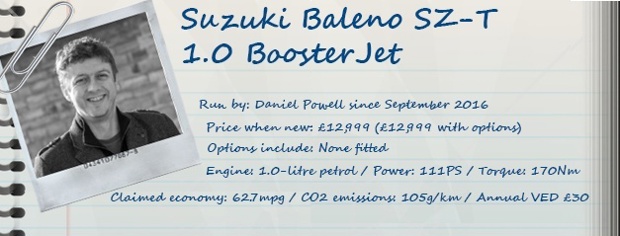
- Suzuki Baleno joins the HJ fleet
- Build quality concerns
- Dial S for super savings
- Creature comforts for cruising
- The pint-sized powerhouse
- Wheeler dealers
- The case for space
- Should you buy winter tyres for a small car?
- Camera, dirt, no action
- Why the Baleno is miles better than the rest
- A clean getaway
- Do we really have to give the Baleno back?
Suzuki Baleno joins the HJ fleet
Suzuki’s small yet practical hatchback has attracted a wave of praise since its launch. We put one to test for six months to see if it’s as good as everyone claims.

Date: 26 September 2016 | Current mileage: 321 | Claimed economy: 62.7mpg | Actual economy: 55.2mpg
Despite what some TV shows would lead you to believe, being a motoring journalist is not all supercars and executive saloons. In fact, I actually spend most of my evenings and weekends driving my partner’s Suzuki Swift, because it is fun, cheap to run and ridiculously easy to drive.
In fact, on paper, the Baleno is impressive and covers all of the basics with an efficient 1.0-litre BoosterJet engine and lots of kit fitted as standard. As a result I’ve not had to fit any expensive extras; instead, I’ve opted for the entry-level SZ-T trim, which includes alloy wheels, air conditioning, navigation and rear-view camera. Front fog lights and DAB audio is also thrown in, along with HID headlights and Bluetooth. Not back for a car that costs less than £13,000.
As mentioned, the Baleno uses a three-cylinder engine and - according to Suzuki - it should provide 62.7mpg. Sadly it doesn’t qualify for zero VED, with the 1.0 BoosterJet emitting 105g/km of CO2. But the engine does pack a little nudge of performance, with 111PS and a useful 170Nm of torque, which work surprisingly well with the Baleno and its light, 880kg kerb weight.
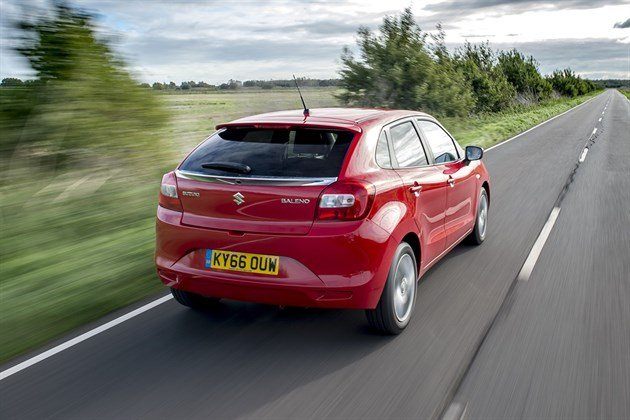
Since its delivery last week, I’ve already clocked up over 300 miles and been impressed with the handling and 1.0-litre engine. Despite its low kerb weight, the Suzuki feels rigid in the corners and responsive, which means you can carry a fair bit of speed in the corners. The 170Nm of torque also means that the Baleno is seldom short of acceleration, owing to the fact it weighs so little.
The seats are firm but comfortable and there is more than enough space for four adults, while the 355-liter boot is more than adequate for a couple of suitcases or the weekly shop. The fit and finish of the interior is also good, while the colour touch screen and leather steering wheel gives the impression that you’re driving a much more expensive car.
Obviously, it’s early days, but first impressions are always important and so far the Suzuki has impressed. Claimed economy is in the mid-50s, but the Baleno only had a few hundred miles on the clock when it arrived and it’s still in the process of being run in. As the weeks tick by, we’ll see how close it can get to Suzuki’s claim of 62.7mpg.
Build quality concerns
The Suzuki Baleno’s value for money and low running costs are impressing Dan, but some built quality concerns are causing a worry.
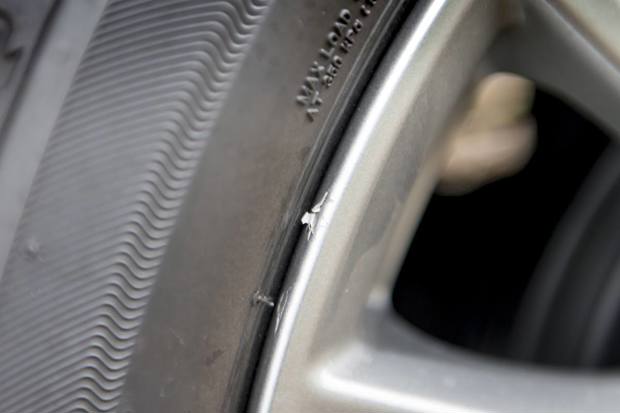
Date: 10 October 2016 | Current mileage: 812 | Claimed economy: 62.7mpg | Actual economy: 57.5mpg
Cheap to run, comfortable and fun to drive, the Suzuki Baleno should tick all of the small car boxes, but last week it presented an unwanted tickbox. The problems started last week when I noticed that the paint was far from perfect on one of the alloy wheels, with the grey finish peeling off (pictured above). Not very good for a car that's just a few weeks old, I'm sure you'll agree.
Then, a few days later, while washing it, I found that the paint finish on the bonnet was missing a couple of spots. The worst bit is on a corner section of the bonnet (pictured below), with the white primer shining through the red paintwork. It's a little disappointing as a cheap car needn't mean corners are cut. Or missed.
To be fair to Suzuki, the issues are minor and easily fixable by the detailing department at any main dealership; however, being a stickler for value, I'm a tad disappointed. In fact, if I was an owner, I'd be inclined to push my dealer for something extra to cover the hassle of painting my car again. Free service, anyone?
The Baleno is actually due to visit my local dealer in a month or two for its winter wheels and tyres, so I'll have the paintwork examined in better detail then and see if they can give me a reason why it has happened.
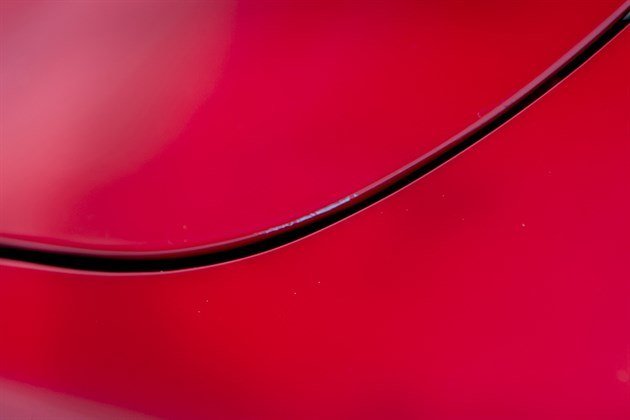
While the Baleno is great to drive, its paintwork disappoints with one or two spots of primer visible
Paintwork aside, the Baleno has impressed; its fuel economy is climbing to the high 50s and its compact size - and parking camera - make it easy to drive in and around my hometown of Cambridge. I've also taken some time to get to know the infotainment system, which is simple to use and program.
The interior, while a little dull, is extremely comfortable. The seats are on the hard side, but they provide superb comfort over long trips, with the wide base and padding preventing the usual aches and pains from the upper leg and lower back region. There's also space for four adults, although headroom in the back can be a little tight for six footers.
The dark and shiny plastics are a little unpleasant to the eye, with a thin covering that fails to muffle the tinny clunks when you open and shut the doors. However, that said, there are no rattles or creaks from any of the interior fixtures, which is always a positive sign that everything has been bolted together with a sense of purpose.
The exterior is a Marmite matter though, with family and friends loving or hating the design in equal measure. Some might think it's a bit of a pug, but I quite like the compact and upright shape, as it fits the Baleno's no-nonsense nature. It's a cheap and easy to use and doesn't get confused with ideas of sports car grandeur. And, with over 55mpg to its name, it's becoming a fast favourite in the Powell household.
Dial S for super savings
If you're looking for a cheap car, with lots of kit and affordable running costs, the Baleno is the way to go, says Dan.

Date: 24 October 2016 | Current mileage: 1331 | Claimed economy: 62.7mpg | Actual economy: 58.9mpg
If there is one thing that Real MPG has taught us then it's don't trust official fuel figures, because a modern car will seldom get anywhere near its claimed economy. In fact, for most drivers, it’s a case of pie in the sky, because some of the latest cars miss their official fuel ratings by 50 per cent. Needless to say that leaves a lot of drivers rather cross.
Thankfully I've not been at all angry with the Baleno, because it appears to be one of the few exceptions to the fuel rule. Over the past few weeks it has been returning a healthy 58.9mpg and that’s not too shabby when you consider that it's less than 3mpg off the official 62.7mpg. What's more, with my daily 40-mile commute covering a mixture of motorways, inner-city driving and A roads, it’s all been achieved in real world driving conditions.
Compared to my previous long-termer, this frugal economy has saved me a fortune. A full tank costs about £40 - at £1.14p-per-litre - and lasts a whole week. The money-saving aspect becomes all the more profound when you consider that this little car costs less than £13,000 to buy new and is packed with equipment that you don't typically get with its rivals.
DAB audio, rear-view camera, tinted glass, navigation and heated door mirrors; these are all things that would cost you thousands as extras for most small cars, yet Suzuki has chucked them all in as standard with its little Baleno. Impressive stuff for those looking to save money with their next car.
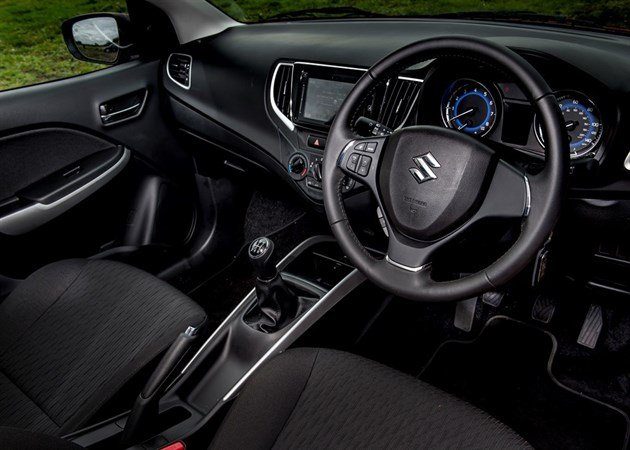
The Baleno might be well-equipped as standard, but its interior is a depressingly dull
Now, before I get carried away - and this starts to read like an advertorial - I should point out that Suzuki's small car is not all sunshine and rainbows. The interior is as dull as a sandpaper conference in Slough, while the 1.0-litre engine is prone to emitting a high pitched turbo whine at 2000rpm. At least I think it's the turbo. Either way, it's pretty annoying when leaving the motorway or chugging behind a lorry in fifth gear.
So the Baleno is not without its faults. Yet, despite these annoyances, I find it hard to take a dislike to the Suzuki. Not only is it good to drive in town, with light steering and comfy seats, but the reserving camera makes parallel parking ridiculously easy. And, as already mentioned, it's cheaper than the cheapest of chip shop chips to run on a daily basis.
I guess what I'm trying to say is that the Baleno is perfect for those who simply want a car that's comfortable, cheap and large enough to ferry four people and luggage. To this end, the Baleno is perfect, but also fun to drive.
On the downside, I had a few issues with the paintwork, but I've managed to fix the paint with a dab of colour polish. To be fair to Suzuki, they also offered to take the car back to resolve the problems. They also assured me that this would be the case with any customer who experienced anything similar. As for the peeling wheel, this will be fixed in the coming weeks when I replace my alloys for winter wheels, but with the cold weather yet to bite, I'm holding back on this until December.
Creature comforts for cruising
With a few weeks of motorway miles under his belt, Dan assesses the Baleno's potential as a long distance cruiser.

Date: 7 November 2016 | Current mileage: 1860 | Claimed economy: 62.7mpg | Actual economy: 59.0mpg
Affordable commuter cars are some of the most popular topics in our Ask section, with hundreds of you asking Honest John for advice on which cars are best for getting to and from work, with the lowest possible outlay.
My daily commute to the HonestJohn.co.uk office is 74 miles, which puts me in the high mileage commuter bracket, with my yearly drive to the office consisting of 22,200 miles. That's quite a lot for most people and puts considerable emphasis on fuel consumption and ride comfort.
Fuel economy is one of the strong suits of the Baleno and, since I took delivery of it six weeks ago, it has regularly averaged in the high 50s. In fact, after 1860 miles, it has peaked at 59.0mpg, which is 2.7mpg short of Suzuki's official rating.
With winter on the way, I doubt I'll achieve any more than that. The cold weather is a traditional drain on fuel economy, with the engine taking longer to warm up and the electrical components – such as the heater and defrosters – usually dragging average economy down. Still, at worst, I anticipate a drop of one or two notches on the mpg score, which will still leave the Baleno 's real world economy miles ahead of the 100PS Ford Fiesta 1.0 EcoBoost.

The Baleno's cabin might not be very colourful, but it is excellent for comfort on long trips
Some days I’m driving two or three hours in the Baleno, which puts a lot of emphasis on the interior quality. After all, it’s all very good saving money on fuel, but if you can’t enjoy the cash due to a crippling back injury then it's not much use, is it?
Most people would be forgiven for thinking that Baleno's low-thrills interior scores poorly for comfort, yet nothing could be further from the truth. Those cheap and hard looking seats are actually brilliant for supporting your back, while the wide base and side padding ensures that the blood flow around your legs doesn’t falter when you're stuck in a three hour queue on the M25.
I accept that the cabin lacks colour or imagination, with the 50 shades grey only being offset by dashes of cheap silver plastic, but everything is easy to find and use. There's also decent interior storage with five cup holders, which will also carry cola or water bottles. The large boot is also large enough to carrying a couple of large suitcases too.
However, the real star of the Baleno show is the turbocharged 1.0-litre BoosterJet engine. Despite having just 111PS, it zips along with decent pace and works really well with the car's 950kg kerb weight. This means you can overtake slow traffic with ease and not have to work the gearbox into a frenzy when it comes to joining a busy motorway.
The pint-sized powerhouse
It might be small in stature, but the Baleno is might when it comes to saving the pennies on fuel.

Date: 21 November 2016 | Current mileage: 2599 | Claimed economy: 62.7mpg | Actual economy: 58.2mpg
It might be small, but the little Baleno is big on surprises. Since taking delivery in September I’ve covered almost 2600 miles and – despite the autumn weather – I’m averaging close to 58mpg. That’s impressively close to the Baleno’s official 62.7mpg.
The three-cylinder BootserJet engine is excellent and packs a little punch, with 170Nm of torque from 2000rpm – 3500rpm. Admittedly, that might not sound like a huge amount of power, but the Baleno only weights 950kg and any more would probably make it a little skittish and unpredictable to drive.
As it is, the Baleno is great to drive, although the turbo whine at 2000rpm does annoy a little when you peel off the motorway or approach a roundabout. It's a pity, because at motorway speeds the 1.0-litre BooterJet is surprisingly refined, with low engine noise and good mid-gear acceleration. However, near 2000rpm, and it sounds a bit bus-like, with a high pitch whirr.
In fact, sometimes the noise is so loud it drowns out the radio, which can really irritate you if you've been driving a long distance and are nearing your destination. I've tried changing down sooner and driving in different styles, but to no avail. The 2000rpm whine will always raise its head, without fail.
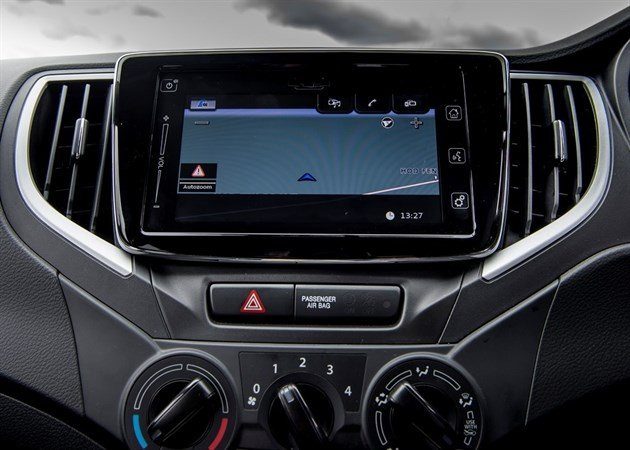
Suzuki's in-built navigation has impressed, although the screen is susceptible to sunlight
With the miles pilling on, I've found myself relying more and more on the built-in navigation over the past few weeks. The system is standard on all Balenos and, for the most part, works well with intelligent directions and a clear map layout. However, it does have a habit of getting confused when you have two or three turns in succession. The screen is also prone to reflecting direct sunlight, which makes it difficult to see the map from time to time.
I've also found the controls for the heater to be a little awkward with the dial turning freely until you reach the red bar. Once engaging the full heat, the dial gets a little stiff and I'm fearful that I'm going to break something when I give it a forceful turn in the mornings to clear the windscreen of frost.
Despite my heavy handedness, nothing has actually broken in the cabin and I've grown to appreciate the comfortable seats, which are firm and raised up to provide excellent lower back support. As mentioned in previous updates, it is no uncommon for me to spend three or four hours behind the wheel, but I've yet to experience any tingle of back pain. Even if my ears are ringing a little from dreaded 2000rpm whine.
The Baleno is booked into my local dealer in a couple of weeks for its winter tyres. This could have some repercussions for the ride and fuel economy - depending on which wheels and tyres are fitted - but until then I'll continue to enjoy the Baleno's excellent all-round comfort.
Wheeler dealers
Suzuki Baleno gets ready for the cold months with a set of winter tyres. How will they impact economy and the handling?
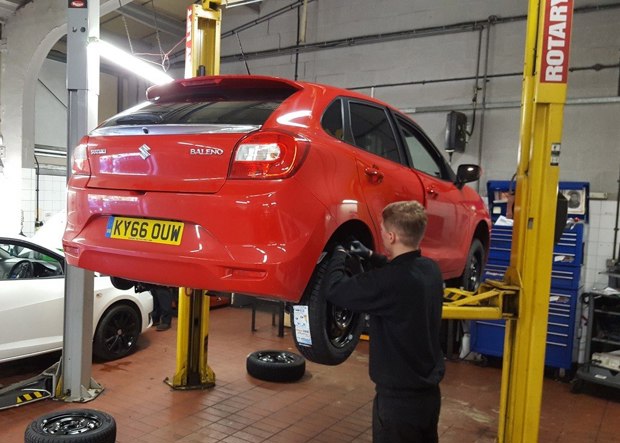
Date: 5 December 2016 | Current mileage: 3171 | Claimed economy: 62.7mpg | Actual economy: 57.1mpg
With winter finally here, I’ve decided to fit winter tyres to the Baleno so it’s ready for whatever the British weather can throw at it. Unfortunately I wasn’t able to choose my own brand of tyres, so I’ve had to accept Hankook ICept RS tyres, which were supplied by Suzuki on 16-inch wheels.
The wheels were fitted by Stoneacre Suzuki in Peterborough, which is located about 10 minutes away from our office. The tyres usually retail from £54 - £80 and promise stronger grip and control in wet and cold conditions, thanks to a four-channel tread pattern and a softer rubber compound that works better at low temperatures.
If you don’t really understand winter tyres then you can read our simple guide. In short, they are optimised to provide better performance when the thermometer reads 7°C or less, which is also the point standard tyres start to suffer and become more slippery.
The impact of the winter wheels is immediate. The Baleno feels better in the corners, with more grip. The front wheels also no longer spin when you attempt to scurry away from a busy junction or roundabout. Sometimes winter tyres can increase road noise levels, but thankfully this isn't the case with the Hankooks as they're quiet and smooth on all road surfaces.
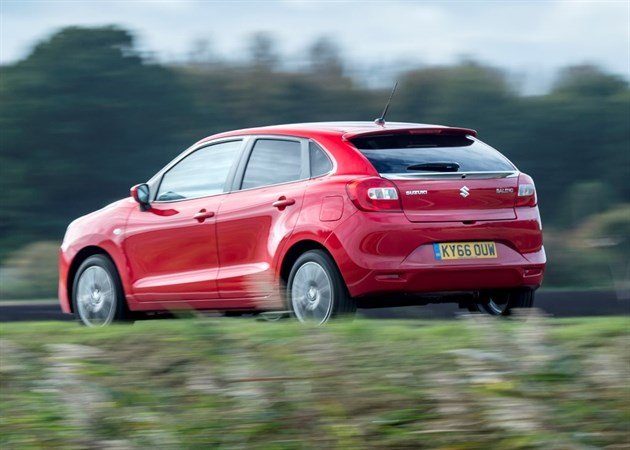
With winter tyres, the front-wheel drive Baleno should be able to cope with all winter has to offer
Fuel economy has continued to dip though, as the cold weather and winter rubber makes the BoosterJet engine work harder. The Baleno is now averaging at 57.1mpg, which isn't bad, with a £35 fill providing me enough fuel for a week-long commute to the office.
I've also found the compact dimensions of the body - 1.7 by 3.9 metes - make the Suzuki great for navigating busy city streets in Peterborough and my hometown of Cambridge. The large door mirrors also provide excellent side visibility, which is handy when it comes to spotting cyclists in Cambridge.
The cold and wet weather has made it difficult to use the rear-view camera though, with the lens easily obscured by water droplets. I think the problem is with the chrome strip that borders the rear window, as the water drips down on to the camera. It's not a huge problem, but it is a little annoying when it comes to parallel parking.
However, with cold weather on the way I'm looking forward to seeing how the Baleno performs with its winter boots on. Being front-wheel drive and lightweight, I'm optimistic that it'll leave some SUVs trailing in its wake when it comes to snow and ice.
The case for space
It might be small in stature, but the Baleno has plenty of interior space and will easily carry four large adults.
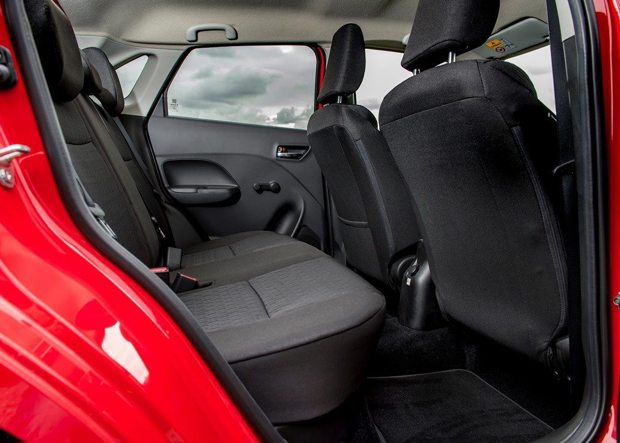
Date: 19 December 2016 | Current mileage: 3994 | Claimed economy: 62.7mpg | Actual economy: 55.9mpg
With Christmas almost upon us, the Baleno has seen its duties change over the past few weeks, with myself and my Suzuki being drafted in as a family taxi. Yet, while the repetition of carrying friends and relatives to train stations, shopping centres and restaurants has become all too tedious, it has allowed me to test the car's practicality.
Stretching just 3.9 metres in length, the Baleno is by no means a large car. Far from it, the Suzuki is only 500mm longer than a Smart, which means passengers usually scoff when they're asked to take a seat in the back or load their cases into the boot.
However, while some may take a disdainful view of the exterior design, I've yet to have any complaints about the interior. Far from it, with four adults in and a few suitcases, the Baleno receives muted praise as "being alright". This is high praise indeed, as most of my relatives are SUV die-hards. As a result small hatchbacks are usually treated as things you give to your kids when you want them to move away or go to university.
The interior will easily fit four adults, while the five-door layout makes it easy for everyone to get in and out, without having to climb over seats or ask people in the front to move. Admittedly, six footers will brush the top of their heads against the roofline in the back, but for the most part the Suzuki is a comfortable for long runs.
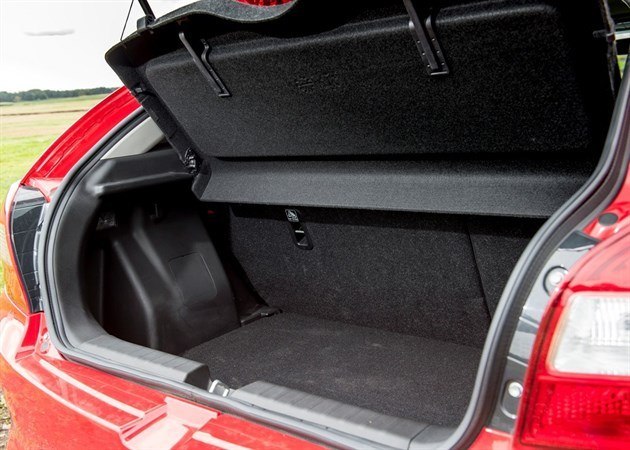
The Baleno has one of the largest boots of any small hatchback, with 320-litres on offer
The boot is actually 40 litres larger than Vauxhall Corsa and Ford Fiesta, which makes the Baleno great for carrying suitcases. The boot space can be expanded to a maximum of 1085 litres by folding the rear seat, although these don’t fold completely flat like they do in a Honda Jazz or Nissan Note.
With its winter tyres on, the Baleno has mountains of grip. This means you can push the little Suzuki along on B roads and make the most of the BoosterJet engine, which in my opinion is one of the best three-cylinder engines around right now.
The winter tyres have impacted fuel economy though; the Baleno now averages at 55.9mpg, which is a far way from the 59.0mpg I was getting in the autumn on all-season tyres. To be fair, the cold weather was always going to impact economy and given how good the Hankook winter tyres are, I'm not overly disappointed with this fact.
The Baleno might not win any awards for its exterior design - it certainly divides opinion with friends and family - but the value-focused nature of the Suzuki is difficult to deny. Especially when you factor in how much kit is fitted as standard.
Should you buy winter tyres for a small car?
Are winter tyres worth the extra money? Dan finds out by fitting a set of Hankooks to the Baleno.
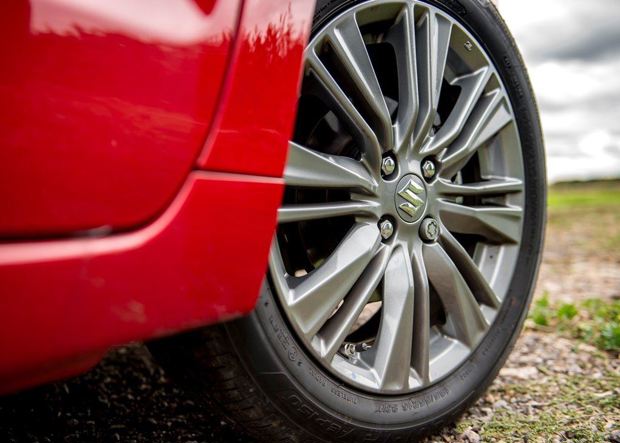
Date: 2 January 2017 | Current mileage: 4799 | Claimed economy: 62.7mpg | Actual economy: 54.6mpg
Winter tyres are popular in Europe as they provide better grip and safer handling when temperatures start to plunge, but are they really worth spending £400 on in Britain? I decided to find out by having a set fitted to the Suzuki Baleno.
For those not in the know, winter tyres are made from a different compound of rubber that uses more silica. They also have extra grooves in the tread, which makes them softer and better at generating heat in low temperatures. Given the past few mild winters, I have to admit that I was in two minds to have winter wheels, but it has turned out to be the right decision, because December and January have been rather cold and snowy.
Unfortunately I wasn’t able to choose my own brand of tyres, so I’ve had to accept Hankook ICept RS tyres, which were supplied by Suzuki on 16-inch wheels. However, despite the lack of choice, the Hankooks have been really impressive, with noticeably more grip and better handling in the wet.
Obviously, the little Baleno isn't built for speed, but with its winter boots on it has proven to be extremely capable on B roads, with mountains of traction. The superb handling has been made all the better for the fact that the Suzuki uses front-wheel drive and weighs just 950kg. As a result it skips over icy roads with the prowess of a mountain hare.
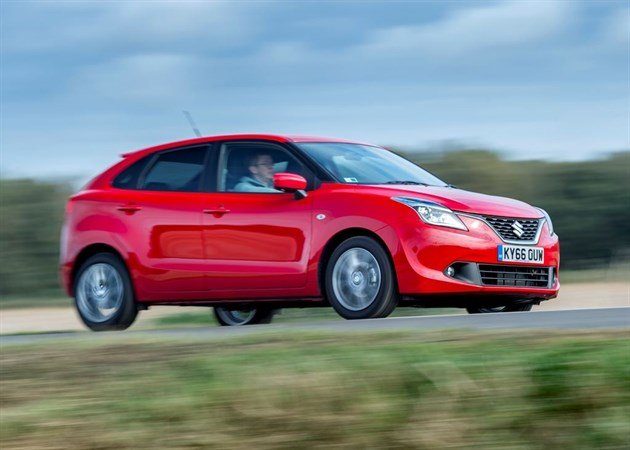
The Baleno impresses with winter tyres, with excellent grip and handling in icy conditions
On the downside, winter tyres do weaken fuel economy a tad. For example, when the Baleno was on its original low rolling resistance tyres, I was getting a pocket pleasing 58.9mpg; however after a few months of winter motoring this has dropped to 54.6mpg.To be fair, this isn't all down to the tyres. The winter takes its toll on other areas and the engine also takes longer to reach optimal running temperature too, but it has all contributed to a drop in economy.
That said, 54.6mpg is still rather good and doesn't change the fact that the Suzuki Baleno costs buttons to run. The Suzuki is also getting impressive Real MPG scores too, which means I am not the only driver who is getting consistently high scores for economy.
I'm a big fan of the turbocharged three-cylinder BoosterJet engine, but the turbo whine is bit of a blot on its otherwise impressive nature. The noise starts at 1800rpm and builds into an annoying whistle at 2000rpm. I've asked my local Suzuki dealer about it, but been told "it's just one of those things" and all of the engines do it.
However, this little Suzuki is an excellent car for value. The navigation is easy to use, the firm but supportive seats are comfy and the podgy styling has rather grown on me. I just wish it'd stop whistling every time it near a motorway...
Camera, dirt, no action
It's been a busy few weeks for Dan and the Baleno, but the winter grime is getting to him and his car.
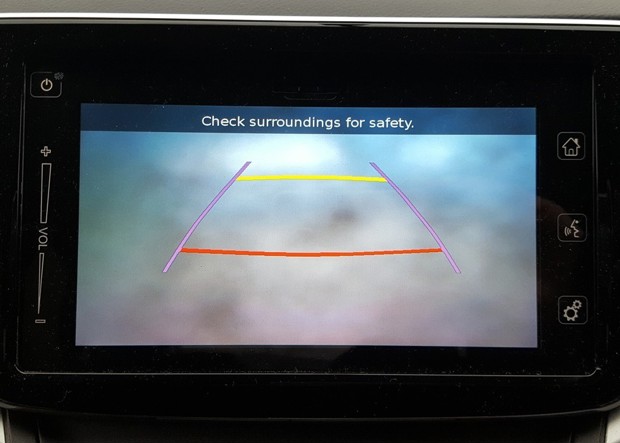
Date: 16 January 2017 | Current mileage: 5489 | Claimed economy: 62.7mpg | Actual economy: 54.5mpg
January is the dullest month of the year for me. The dark, the cold and the endless road grime are really enough to make you want to go home and hibernate until the spring. However, being a car journalist, January is also one of the busiest and over the past two weeks I've clocked up almost 700 miles in the Baleno.
Most of the travel has been on the motorway, with the A14 and M1 being regular haunts as I travel up and down the country to cover new car launches and events. As a result the Baleno has been transformed from a bright shade of red to a grimy shade of grey, which has presented one or two problems. The biggest issue is with the rear view camera. Now I know I shouldn't really need one in the Baleno - the car only measures four metres long - but it has been rendered useless by road dirt.
The problem is caused by the location of the lens, which placed in the bootlid housing. This seems to be a dirt trap and the camera gets smothered in filth making it impossible to see anything on the in-car display. I've tried washing the car, cleaning the lens each week, but within an hour of motorway driving it becomes smothered and impossible to read again.
I know the camera is a standard fit option and doesn't cost any extra, but those who aren’t confident at parking will find its location - and vulnerability to road dirt - a bit of an issue. Thankfully, as editor of Honest John Vans, I am well accustomed to the art of reversing with limited rear visibility, although the rear wash and wiper in the Baleno makes it easy to keep the rear screen clear.

The rear view camera captures everything, including road dirt, mud and grime
With its winter tyres, the Baleno continues to cope with everything else winter can chuck its way, with excellent handling and almost unlimited levels of grip. Usually, in a front-wheel drive car, the wheels will spin when you attempt to join a fast flowing A road, but the winter tyres prevent this from happening and you can pretty much drop the clutch and scurry away into a gap in the traffic without incident.
With the additional miles, I've had a newfound appreciation for the interior. The seats are really good and, while they look a tad cheap and dull, are perfect for long trips with a firm base and plenty of side support that provides excellent comfort for the back and upper legs.
The dashboard isn't the most attractive and the interior plastics won't win any premium prizes, but everything is within easy reach. The infotainment system is simple too, which means everything - radio stations, navigation and media - are just one screen change away.
However, the star of the show here is the low running costs. Even in sub-zero conditions and on winter tyres, the Baleno is averaging 54.5mpg which isn't that far from the advertised 62.7mpg. It's also worth noting that, in the summer, with standard tyres, I was getting 58.9mpg, which makes the Suzuki an affordable and likeable daily driver.
Why the Baleno is miles better than the rest
Fuel prices might be going up, but none of that matters when you drive a Suzuki Baleno.
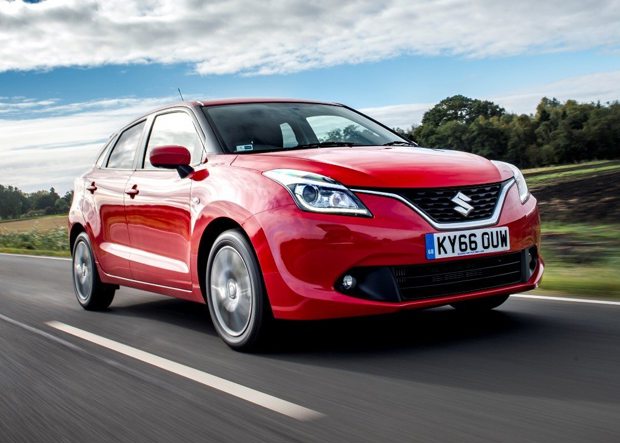
Date: 30 January 2017 | Current mileage: 6299 | Claimed economy: 62.7mpg | Actual economy: 54.7mpg
As the miles clock up, so does my appreciation for the Suzuki Baleno. As mentioned in some of my previous updates, this hatchback is brilliant for fuel economy. In fact, with an average of 54.6mpg, it’s providing the sort of Real MPG score that you’d expect from a diesel.
The fuel sipping economy is all down to Suzuki’s excellent 1.0-litre BoosterJet engine. Like Ford’s EcoBoost, it’s a turbocharged three-cylinder petrol. However, unlike the Fiesta, it doesn’t miss its advertised economy ratings by a whopping 20mpg. That means the Suzuki is much more honest than its rivals when it comes to its real world fuel economy.
The official economy for this particular model should be 62.7mpg, but I’m currently averaging at 54.7mpg, which isn’t too bad given that we’re in the depths of winter. The winter tyres also impact economy too, which makes a shortfall of 7.0mpg quite acceptable in my book. It's just a pity that the engine lacks refinement, with the turbo whine being the only fly in the proverbial ointment.
With its winter tyres on, the Baleno has munched through winter as if it wasn't really there. The Hankook ICept RS tyres, which were supplied by Suzuki on 16-inch wheels, have done a great job. They provide more grip in icy conditions and better handling in the wet. They also provide much more confidence when it comes to making an emergency stop, by cutting braking distances.

The Baleno on winter tyres is more than a match for the gloomy skies of winter
As well as costing buttons to run on a daily basis, the Baleno continues to show that a low-thrills interior can do everything its plusher rivals can, with superb levels of comfort and usability. Over the past few weeks I've covered 800 miles, yet there has been none of the usual back aches, leg pains or muscle issues. Indeed, the Suzuki is excellent for covering long distances.
One thing I have noticed about the Suzuki is the steering is a little on the light side, which means it isn't the sharpest thing to drive. For the most part, it doesn't really matter, but if you put the Baleno to task on a B road then you do notice the vagueness in the handling. Obviously, this isn't a car built for speed, but it would be nice if the handling was a little sharper.
I have no complaints about practicality. The 355-litre boot will take everything from the weekly shop to large suitcases for trips to the airport. Lowering the rear seats is also easy, with the wide boot opening making it easy to load bulky items without chipping the paint off the bumper or damage the sills.
Sadly my time with the likeable little Suzuki is coming to an end. It goes back in a few weeks, but I'm planning to get quite a lot of mileage under my belt before that happens. Who knows, perhaps the only blot on the Baleno landscape will vanish and that annoying turbo whine will finally go away...
A clean getaway
With a weekend away booked, Dan gives the Baleno a long overdue clean with the Sealey PW2500 pressure washer.
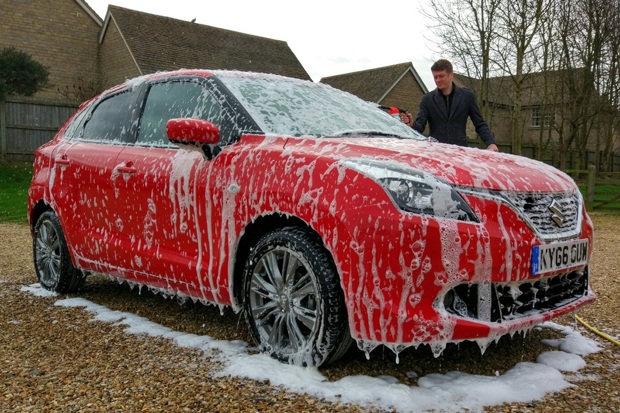
Date: 13 February 2017 | Current mileage: 7103 | Claimed economy: 62.7mpg | Actual economy: 55.9mpg
I hate washing cars in winter. The cold weather, the wisps of snow in the air and buckets of freezing cold water; none of it is attractive when it comes to trudging outside to washing the car. Far from it. If anything, winter car washing is a one-way ticket to man flu. And we all know how dangerous that can be to a gentleman’s health.
However, with trip to a friend's wedding approaching, I couldn't avoid washing the Baleno much longer. The bodywork was caked in road dirt and salt, which had transformed the bright Fire Red paintwork into a less sexy version of Fifty Shades of Grey. Thankfully, while no one was looking at the office, I borrowed a pressure washer that was awaiting a product test.
The pressure washer in question was the Sealey PW2500. Despite sounding like a character the Terminator movies, the unit is a pressure washer with a 200W motor. It costs £215 to buy and boasts 170 bars of pressure, which means it will pump through 438 litres in an hour.
Setting up the PW2500 was easy; you simply roll it out to the car, plug it into the mains and then attach the hose pipe. The power lead is quite long, which means you can thread it through an open window to plug it in. You then attach the water hose pipe and away you go.
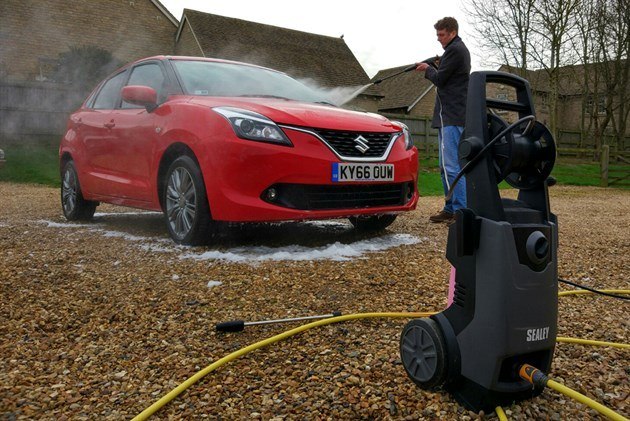
The Suzuki gets a long overdue wash with the Sealey PW2500 pressure washer
Once the soap was applied, via a separate tank that's attached to the pressure washer, it's a simple case of blasting the suds off with clean water. The side mounted gun is lightweight and has a five metre hose that allows you to walk around the car and wash all the dirt off. It also has an automatic switch off when you take your finger off the trigger, so you don't accidently soak yourself.
The job took 10 minutes in total and did a great job of clearing the mud off the Baleno, although the gun does vibrated quite heavily and this could make it unsuitable for older people or those with any health problems that relate to their hands or wrists. Even a strong and burly man like myself - stop sniggering at the back - found the vibrations to be a little harsh after 10 minutes.
With the Baleno clean I have continued to rack up the miles. In fact, I've covered 800 miles these past two weeks. The fuel economy continues to impress, with an averaging that's close to 60mpg, which means it really is excellent value on fuel. And an easy car to budget for when it comes to calculating monthly running costs.
Sadly my time with the little Suzuki is drawing to a close. Indeed, I hand the keys back in two weeks, which I'm really dreading. Not only have I grown to love the Baleno's nimble and easy going nature, but I'm really, really, really going to miss the fact that it costs buttons to run.
Do we really have to give the Baleno back?
It's time to say goodbye to the Suzuki Baleno. Dan's bank account is going to miss you.

Date: 27 February 2017 | Current mileage: 7641 | Claimed economy: 62.7mpg | Actual economy: 56.0mpg
The day to hand the Baleno back has arrived. Over the past six months the Suzuki has surprised and impressed the Powell household and I'm sorry to wave goodbye to what is an excellent little car. For sure, the podgy styling is not to everyone's tastes, but is it difficult to deny the value and practicality of the brilliant little Baleno.
So, let’s start with what’s really good about this car. To kick off, it's brilliant value for money. My test car is the entry-level model in SZ-T trim, which costs £12,999, but it pretty much has everything you could ever need, with navigation, alloy wheels, air con, rear-view camera and front fog lights all included as standard.
The turbocharged three-cylinder petrol engine is good too. The 1.0 BoosterJet produces just 111PS, but works well with the Baleno’s 880kg kerb weight with zippy performance and lots of mid-gear torque. It’s also cheap to run, with the 1.0-litre engine averaging at 56.0mpg after six months and 7641 miles.
The interior is another area that has won praise over the past six months. Admittedly, it doesn't look much, with lots of cheap and scratchy plastics, but the cabin is easy to clean and durable. The hard, upright seats are also extremely comfortable and provide superb support for long stints behind the wheel, while the 355-litre boot is bigger than anything you'll find in the Ford Fiesta or Vauxhall Corsa.
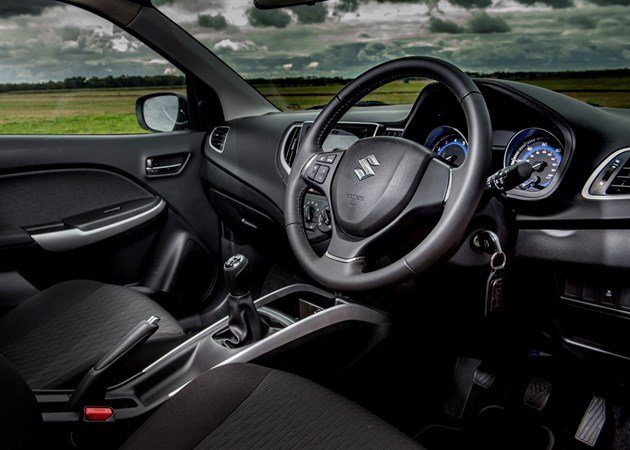
The Baleno's low-thrills interior is comfortable and practical. The boot is huge too
So what's bad about the Suzuki Baleno? Well, not a lot to be honest. The handling isn't the sharpest and the steering is a little vague in the corners, but for the most part the Baleno goes about its everyday business with ease. It's competent motorway cruiser too, although it does have one or two niggles.
One thing that has really irritated me is the turbo whine. The noise usually appears between 1800rpm - 2000rpm and results in a high pitched whistle that only goes away when you take the revs down to 1500rpm or above 2100rpm.
Whistling woes aside, there is very little else to criticise the Baleno for. It is incredible value. Its real world fuel economy is also nothing short of brilliant. Indeed, it is already establishing itself a strong reputation on Real MPG and I cannot overstate how few cars ever get close to matching their advertised fuel figures.
Add in the high levels of standard kit and the affordable list price and it is easy to see why the Suzuki Baleno is such a great little car. In fact, for the money, I struggle to think of any other small hatchbacks that come close to matching it for value or comfort.
